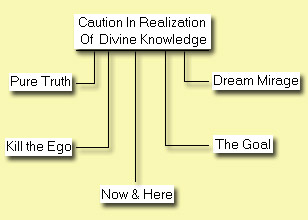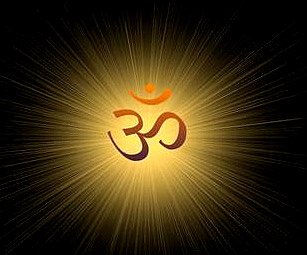 The second chapter of the Kenopanishad has explained the concepts of `Pure Truth`, `The Dream Mirage`, `Kill the Ego`, `The Goal` and `Now and Here`. The second chapter says that one should be cautious in order to realise the divine knowledge, one need to delve deeper and to find out the Pure Truth and Pure Existence. The Pure Truths lie beyond and behind all names and forms. As one realises the Pure Existence, all forms of names and forms gets merged into it. It says that only the conditioned atman can be explained by the scriptures and by the teachers but the pure atman can be explained by the disciple himself intimately. In this regard the Guru once again mentions that an individual should be cautious to decipher the true nature of the pure atman and not mistake it with the conditioned atman. But at the same time the fact remains that with the understanding of the conditioned Brahman we will never be able to attain our true goal.
The second chapter of the Kenopanishad has explained the concepts of `Pure Truth`, `The Dream Mirage`, `Kill the Ego`, `The Goal` and `Now and Here`. The second chapter says that one should be cautious in order to realise the divine knowledge, one need to delve deeper and to find out the Pure Truth and Pure Existence. The Pure Truths lie beyond and behind all names and forms. As one realises the Pure Existence, all forms of names and forms gets merged into it. It says that only the conditioned atman can be explained by the scriptures and by the teachers but the pure atman can be explained by the disciple himself intimately. In this regard the Guru once again mentions that an individual should be cautious to decipher the true nature of the pure atman and not mistake it with the conditioned atman. But at the same time the fact remains that with the understanding of the conditioned Brahman we will never be able to attain our true goal.
This chapter of the Kenopanishad has advised that only by remembering the name of the Lord can one make his mind free from all kinds of worldly desires and when all Vasanas or worldly desires are removed from the mind, individuals are able to soar higher in the spiritual realm. Constant meditation enables the human mind to rise to the divine nature.
As this section of the Upanishad moves forward and goes on to explain the concept of Pure Truth it says that one who seeks Moksha or salvation asks much more than the conditioned atman. It says that beyond the conditioned atman there is a Truth that is beyond any conditioning. It has said that the Atman or the Brahman cannot be seen or heard, it can only be realised. When the individuals end their ego it is only atman that remains with a vital personal experience.
 This section of the chapter has explained the importance of OM. It has said that with the utterance of OM, the concentration of a person is fixed and once the attention of the individual is fixed he is able to travel towards the `Bliss Silence` whereby he experiences the Transcendental Truth.
This section of the chapter has explained the importance of OM. It has said that with the utterance of OM, the concentration of a person is fixed and once the attention of the individual is fixed he is able to travel towards the `Bliss Silence` whereby he experiences the Transcendental Truth.
The subjective Experience alone can give Knowledge of the Pure Atman and Truth without any conditioning. In this subjective Atman-anubhava alone can man reach the fulfillment of ones life`s Divine Mission.
The discussion of `The Dream Mirage` says that only the annihilation of the ego can allow a person to experience the Absolute Truth. The intellect of human kind when dimmed by the fumes of jealousy, anger, passion and lust, the ego-centric entity in individuals gets modified in individuals. And at this juncture the human mind is periled by sorrows and indignation. Therefore a true sadhaka wants to rise above all sorrow and exist in absolute peace. It is said that the Brahma Vidya has prescribed a practice which the mind and the intellect needs to undergo in order to forego the mental unrest. As individuals end the ego he is able to carry out an inquiry into the self and gradually proceed towards knowing the Pure Truth. According to the Kenopanishad when the ego gets completely sublimated then one can achieve the transcendental experience which allows the individual to experience ones true nature.
An important aspect of this section is that it says that words are not enough to express the Absolute Truth because the self realisation is a complex phenomenon which is more subjective in nature. The Supreme Reality when experienced shall be known as the Real Self. The Self which is Knowledge Absolute cannot be known by another knower other than Itself and at the same time cannot be expressed in words.
When the second chapter of the Kenopanishad talks about `Kill the Ego` it says that human beings are living in this world with a false sense of ego. It says that only knowledge of the atman can ward off the ego-sense from the lives of men and when the ego sense is discarded individuals come to know the Real Self. Gradually as the individuals come to realise the Real Self the notion of anything which is Unreal vanishes. When the notion of Unreal disappears one is enabled to come closer to the Lord and as one comes close to the Supreme Being he is able to experience a kind of Supreme Consciousness. As the Truth is deciphered by a man, there remains no difference between the experience and the experienced. In order to continue the experience of Truth one needs to practice regular meditation. The culmination of this meditation or Sadhana is an Infinite Ocean of Bliss and Perfection or the Real Nature. This state of Infinite Bliss is also known as the Samadhi. Hence it can be said that the central theme of this section of the Upanishad is total annihilation of the inner enemy, the Ego. It has declared through its teachings that only by killing the ego can one receive redemption and this redemption can be achieved by following the path of love and devotion. Finally under the guidance of love and devotion can one realise ones True Self. Thus it can be said that one should also be cautious about annihilating the ego-sense in order to achieve the Supreme Knowledge.
The Upanishad says that the ultimate goal of every devotee is to purify the inner instruments. When a devotee has made his inner instruments perfect he is in a position to detach him from all physical body consciousness. As one comes away from his physical body consciousness he automatically is able to detach his mind from the physical world as a whole. Thus it can be said that a devotee or a Yogi with disinclination towards the physical world is able to concentrate on his inner self and at the same time travels in the path to know his True Self. This section of the Kenopanishad goes on to say that when one gives off the gross worldly elements only then can he reach a position whereby he will recognise the atman or the True Self. Hence the gist is that without renunciation, no enduring successes can ever be gained by any one. The animals must slowly give up their hardness and gross physical capabilities if they are to gain the subtler power of a blossomed mind and intellect. The Masters of wisdom unanimously cry that if a man was to make one little renunciation he shall step over to the Realms of the Divine.
The last section of the second chapter has said that mere physical disappearance from the universe does not guarantee an individual the path of Truth. Only by warding off the grossness of mortal life one can be enlightened by the Divine Light. At the same time self discovery is an important step for merging with the Supreme Being. Self Discovery on the other hand is a vital subjective experience which purifies the inner instruments of the self. An important aspect of this part of the Upanishad is that it has declared that True Self can be discovered during ones life time and death is not a necessary impediment for the knowledge of the atman.
Therefore the second chapter of the Kenopanishad has declared that being cautious in all aspects is absolutely necessary for acquiring of Divine Knowledge. The Divine Knowledge comprises realising the atman and unless the atman which is actually the seat of the Supreme Being is realised, one will not be able to reach the state of Infinite Bliss. Hence we can say that the teacher advises his disciple in the second chapter that whatever one does one should be careful because unless one walks in the proper path it is not possible to acquire the Divine Knowledge.



















